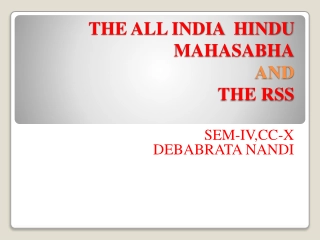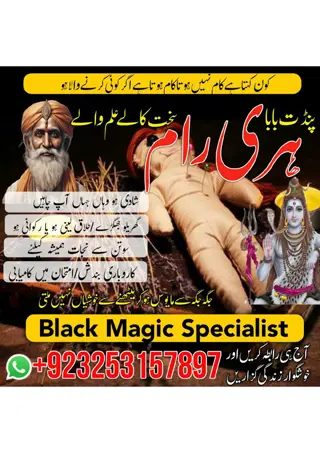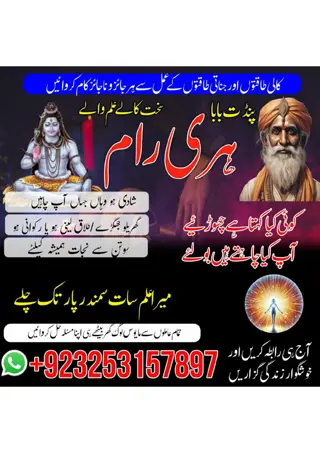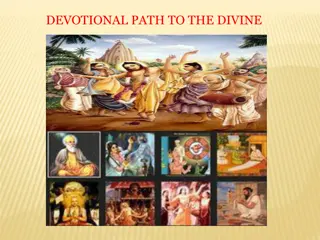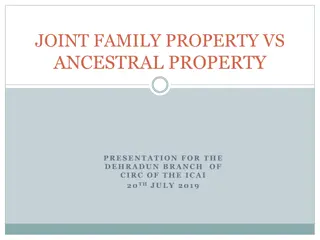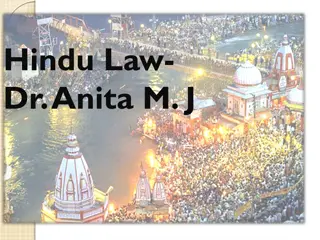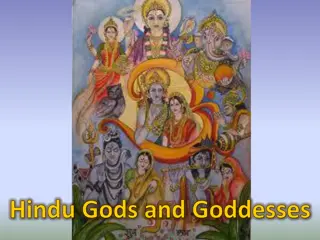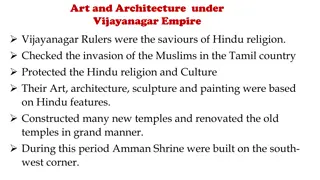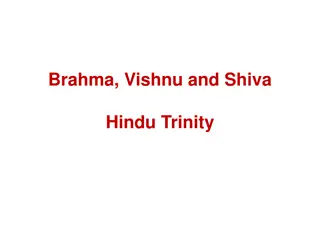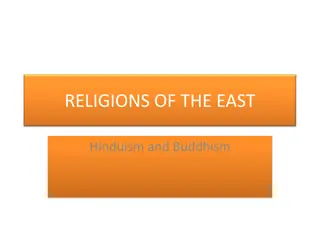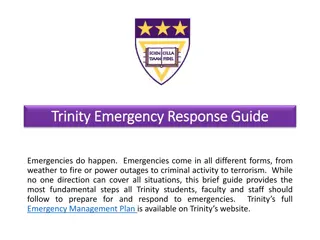The Hindu Trinity: Brahma, Vishnu, and Shiva
The Hindu Trinity consists of Brahma, Vishnu, and Shiva, representing creation, preservation, and destruction respectively. Brahma is the creator, Vishnu the preserver, and Shiva the destroyer. Each deity has distinct significance and symbolism in Hindu mythology, exemplifying the cosmic cycle of creation and dissolution.
Download Presentation

Please find below an Image/Link to download the presentation.
The content on the website is provided AS IS for your information and personal use only. It may not be sold, licensed, or shared on other websites without obtaining consent from the author.If you encounter any issues during the download, it is possible that the publisher has removed the file from their server.
You are allowed to download the files provided on this website for personal or commercial use, subject to the condition that they are used lawfully. All files are the property of their respective owners.
The content on the website is provided AS IS for your information and personal use only. It may not be sold, licensed, or shared on other websites without obtaining consent from the author.
E N D
Presentation Transcript
Brahma, Vishnu and Shiva Hindu Trinity
Lord Brahma, Lord Vishnu, Lord Shiva Brahma (Creator of the Universe) Shiva (Destroyer of the Universe) Vishnu (Preserver of the Universe)
God has limitless & infinite power MAA AADHYA SHAKTI A very tiny part of that ultimate power is AUM AUM creates LORD VISHNU (NAARAYAN) From the belly, Lord Vishnu creates a very powerful and shiny LOTUS Lotus which was created by Lord Vishnu, creates LORD BRAHMA From Lord Brahma s forehead exploded (Praakaty) LORD SHIVA
Lord Brahma and Saraswati Saraswati (Goddess of Knowledge) Brahma Brahma is said to be the Lord of creation. The creator must necessarily possess the knowledge to create. Without knowledge no creation is possible. Hence Brahma is said to be wedded to the goddess of knowledge, Saraswati. Goddess Saraswati is the Goddess of Knowledge and refinement
Lord Brahma Four Heads Lotus Flower Manuscript or Vedas Rudraksha Mala Lotus Flower Kamandalu or water-pot
Lord Brahma Four Heads looking at all four sides: Represents four vedas. The Lord has in his four hands a water-pot (kamandalu), a manuscript (Vedas), a sacrificial implement (sruva) and a rosary (mala). He wears the hide of a black antelope and his vehicle is a swan {hamsa). Lotus: The lotus represents the Reality. Brahma sitting on the lotus indicates that he is ever-rooted in the infinite Reality. Reality is the foundation on which his personality rests The animal hide worn by Brahma stands for austerity. A seeker who desires to realise his godhead must first go through spiritual disciplines. Scriptures: Observing such austerities the seeker must carefully study and reflect upon the scriptural truths which are suggested by the manuscript (Vedas) held in one hand. Sacrificial implement (sruva): Having acquired the knowledge of scriptures he must work in the world without ego and egocentric desires, that is engage in dedicated and sacrificial service for the welfare of the world. This idea is suggested by the sacrificial implement held in the second hand. Kamandal: Kamandal is a water-pot used by a sanyasi-a man of renunciation. It is a symbol of sanyasa or renunciation. The mind of such a man which is withdrawn from the heat of passion of the world is available for deeper concentration and meditation. The rosary (mala) in the fourth hand is meant to be used for chanting and meditation. Meditation is the final gateway to Realization. Through deep and consistent meditation the mind gets annihilated and the seeker attains godhood. A swan is described in Hindu mysticism as possessing the unique faculty of separating pure milk from a mixture of milk and water. It is reputed to have the ability to draw the milk alone and leave the water behind. Similarly does a man of Realization move about in the world recognizing the one divinity in the pluralistic phenomena of the world.
Lord Vishnu and Lakshmi Vishnu Lakshmi Lord Vishnu, major god of Hinduism and Indian mythology, is popularly regarded as the preserver of the universe. His wife is Goddess Lakshmi (also known as Shri), is goddess of fortune.
Lord Vishnu Serpent (Shesha Nag) Disc or Vaijra (chakra) Conch or Sankha Mace Lotus or Padma
Lord Vishnu Lord Vishnu is depicted as dark blue or black (his avatars appear in other colors). Normally, he is depicted with four arms: One hand holds a lotus; a second holds a conch; a third holds a discus (which always returns by itself after being thrown); and the fourth carries a mace. The petals of the lotus are believed to symbolize the unfolding of creation. The conch is said to symbolize that from which all existence originates. The discus and the mace reputedly were obtained by Lord Vishnu as rewards for defeating the God Indra. Lord Vishnu rides a huge creature, half bird and half man, called Gandara. His home is in a heaven called Vaikuntha (where the Ganges River is believed to flow from its source at Vishnu's feet).
Lord Vishnus Avatars Occasionally, the balance of power on earth between good and evil is upset in favor of evil, and then Lord Vishnu is believed to descend to earth in a mortal form (his avatar) to save humankind or the world. Ten such avatars (descents or incarnations) are commonly recognized, of which Lord Rama and Lord Krishna are the most important. Nine descents are thought to have already occurred; the tenth and last is yet to come. Nine avatars of Vishnu are: Matsya or Fish incarnation Kurma or Turtle incarnation Varaha or Boar incarnation Narasingha or Lion incarnation Vamana or Dwarf incarnation Parasurama Ram Krishna Buddha Kalki
Lord Shiva and Parvati Parvati with Lord Ganesh Shiva Shiva is one of the gods of the Trinity. He is said to be the god of destruction. Shiva is married to the Goddess Uma or Parvati. Goddess Parvati represents Shakti. She also represents prakriti which means perishable matter. Shiva's marriage with Uma signifies that the power of destruction has no meaning without its association with perishable matter.
Lord Shiva- an ascetic River Ganga Trishul Third eye Snake around his neck Blue Throat Dhamru Rudraksha Mala
Different Aspects of Lord Shiva The unclad body covered with ashes: the unclad body symbolizes the transcendental aspect of the Lord. Since most things reduce to ashes when burned, ashes symbolize the physical universe. Matted locks: Lord Shiva is the Master of yoga. The three matted locks on the head of the Lord convey the idea that integration of the physical, mental and spiritual energies is the ideal of yoga. The crescent moon: is shown on the side of the Lord's head as an ornament, and not as an integral part of His countenance. The waxing and waning phenomenon of the moon symbolizes the time cycle through which creation evolves from the beginning to the end. Half-open eyes: when the Lord opens His eyes, a new cycle of creation emerges and when He closes them, the universe dissolves for creation of the next cycle. The half-open eyes convey the idea that creation is going through cyclic process, with no beginning and no end. Snake around the neck: sages have used snakes to symbolize the yogic power of Lord Shiva with which He dissolves and recreates the universe. Like a yogi, a snake hoards nothing, carries nothing, builds nothing, lives on air alone for a long time, and lives in mountains and forests. The venom of a snake, therefore, symbolizes the yogic power. Rudraksha necklace: Rudra is another name of Shiva. Rudra also means "strict or uncompromising" and aksha means "eye." Rudraksha necklace worn by the Lord illustrates that He uses His cosmic laws firmly - without compromise - to maintain law and order in the universe. The necklace has 108 beads which symbolize the elements used in the creation of the world. Varda Mudra: the Lord's right hand is shown in a boon- bestowing and blessing pose. As stated earlier, Lord Shiva annihilates evil, grants boons, bestows grace, destroys ignorance, and awakens wisdom in His devotees. Trident (Trisula): a three-pronged trident shown adjacent to the Lord symbolizes His three fundamental powers (shakti) of will (iccha), action (kriya) and knowledge (jnana). The trident also symbolizes the Lord's power to destroy evil and ignorance. Damaru (drum): a small drum with two sides separated from each other by a thin neck-like structure symbolizes the two utterly dissimilar states of existence, unmanifest and manifest. When a damaru is vibrated, it produces dissimilar sounds which are fused together by resonance to create one sound. The sound thus produced symbolizes Nada, the cosmic sound of AUM, which can be heard during deep meditation. According to Hindu scriptures, Nada is the source of creation. Kamandal: a water pot (Kamandal) made from a dry pumpkin contains nectar and is shown on the ground next to Shiva. The process of making Kamandalu has deep spiritual significance. A ripe pumpkin is plucked from a plant, its fruit is removed and the shell is cleaned for containing the nectar. In the same way, an individual must break away from attachment to the physical world and clean his inner self of egoistic desires in order to experience the bliss of the Self, symbolized by the nectar in the Kamandalu. Tiger skin: a tiger skin symbolizes potential energy. Lord Shiva, sitting on or wearing a tiger skin, illustrates the idea that He is the source of the creative energy that remains in potential form during the dissolution state of the universe.
Cycle of Creation and Destruction Life in this world is a manifestation of the three principles of creation, sustenance and destruction. In fact these three are interconnected. The apparent destruction is only an essential forerunner to creation. Destruction and Creation go hand in hand. They are like two sides of a coin. For example, the destruction of morning is creation of noon and the destruction of noon is creation of night. This chain of continuous destruction and construction maintains the day. Similarly, the destruction of childhood is the creation of youth and the destruction of youth the creation of old age. In this process of birth and death the individual is maintained. Hence the three gods of the Trinity viz. Brahma, Vishnu and Siva representing creation, maintenance and destruction, are essentially one and the same.
Lord Shankar (Shiva) : Rudra Exploded (Praakaty) from Lord Brahma's forehead Created similar angry and violent devotees Asked to stop more such creation Asked to perform Bhakti (Bhajan) Went to Kailash Bhakti : Bhakt : Bhagawant : Guru Lord who pleases the quickest Namah Shivaay & Water Abhishek Ganga Maa on head, Poison in throat Becomes Lord Hanuman to assist Lord Ram Lord Shankar is IISHWAR


